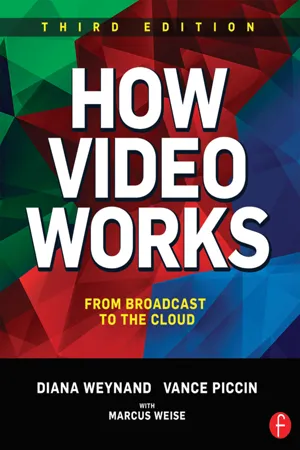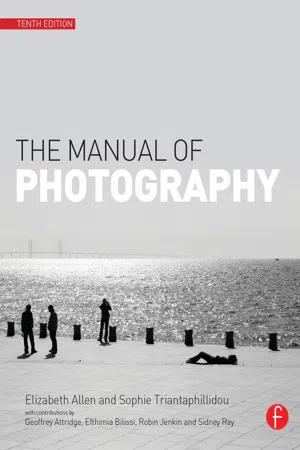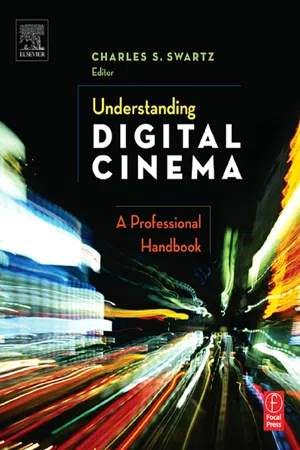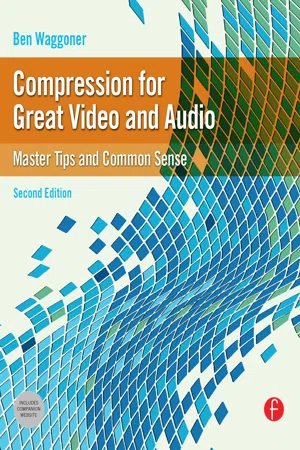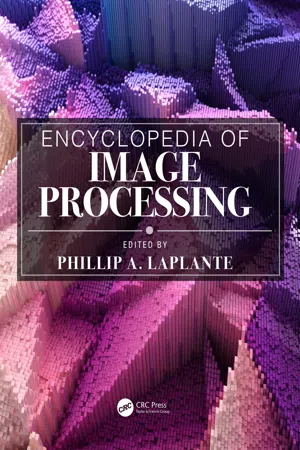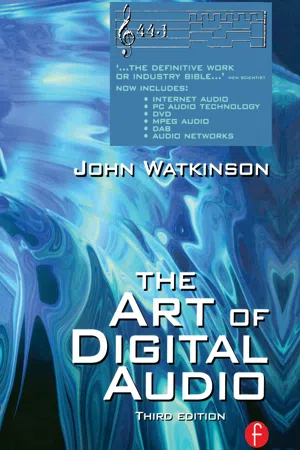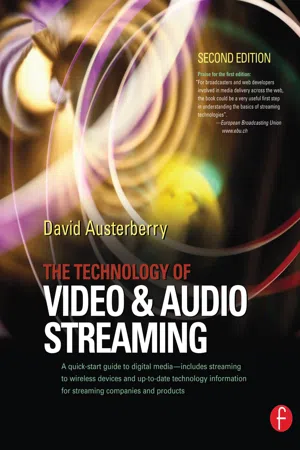Lossless Compression
Lossless compression is a method of reducing the size of data without losing any information. It achieves this by identifying and eliminating redundant data. When the compressed data is decompressed, it is restored to its original form without any loss of information. This technique is commonly used in computer science to reduce file sizes without compromising data integrity.
8 Key excerpts on "Lossless Compression"
- eBook - ePub
How Video Works
From Broadcast to the Cloud
- Diana Weynand, Vance Piccin(Authors)
- 2015(Publication Date)
- Routledge(Publisher)
...14 Compression Compression is the process of reducing data in a digital signal by eliminating redundant information. This process reduces the amount of bandwidth required to transmit the data and the amount of storage space required to store it. Any type of digital data can be compressed. Reducing the required bandwidth permits more data to be transmitted at one time. Compression can be divided into two categories: lossless and lossy. In Lossless Compression, the restored image is an exact duplicate of the original with no loss of data. In lossy compression, the restored image is an approximation, not an exact duplicate, of the original (Figure 14.1). Lossless Compression In Lossless Compression, the original data can be perfectly reconstructed from the compressed data that was contained in the original image. Compressing a document is a form of Lossless Compression in that the restored document must be exactly the same as the original. It cannot be an approximation. In the visual world, Lossless Compression lends itself to images that contain large quantities of repeated information, such as an image that contains a large area of one color, perhaps a blue sky. Computer-generated images or flat colored areas that do not contain much detail—e.g., cartoons, graphics, and 3D animation—also lend themselves to Lossless Compression. Figure 14.1 Lossless vs Lossy Compression One type of Lossless Compression commonly used in graphics and computer-generated images (CGI) is run-length encoding. These images tend to have large portions using the same colors or repeated patterns. Every pixel in a digital image is composed of the three component colors—red, green, and blue—and every pixel has a specific value for each color...
- eBook - ePub
- Elizabeth Allen, Sophie Triantaphillidou(Authors)
- 2012(Publication Date)
- Routledge(Publisher)
...The aim is that the decompressed version of the dataset is as close to the original as possible. However, it is important to note that compression may be lossless or lossy. Lossless Compression methods, as the name suggests, compress data without removing any information, meaning that after decompression the reconstruction will be identical to the original. However, the amount of compression achieved will be limited. Certain types of information require perfect reconstruction, and therefore only lossless methods are applicable. Lossy compression methods remove redundancy in both data and information, incurring some losses in the reconstructed version. Lossy compression is possible in cases where there is some tolerance for loss and depends on the type of information being represented. An example of such a situation is one where some of the information is beyond the capabilities of the receiver. This process is sometimes described as the removal of irrelevancies. In lossy methods there is always a trade-off between the level of compression achieved and the degree of quality loss in the reconstructed signal. Types of redundancy Mathematically, the process of compression may be seen as the removal of correlation within the image. There are a number of different areas of redundancy commonly present in typical digital images: • Spatial redundancy (see Figure 29.2). This type of redundancy refers to correlation between neighbouring pixels and therefore inherent redundancy in the pixel values (also known as interpixel redundancy). The correlation may consist of several consecutive pixels of the same value, in an area where there is a block of colour, for example. More commonly in natural images, however, neighbouring pixels will not be identical, but will have similar values with very small differences. In images where there are repeating patterns, there may be correlation between groups of pixels...
- eBook - ePub
Understanding Digital Cinema
A Professional Handbook
- Charles S. Swartz(Author)
- 2004(Publication Date)
- Routledge(Publisher)
...In one respect this is obviously the ideal form of compression in that (assuming error-free transmission) there can be no possibility of degradation. This is Lossless Compression, and it does have practical applications. Well-known computer programs such as PK-Zip and Stuffit are Lossless Compression systems. They can take a computer file, make it more compact for storage or transmission, and then restore a perfect copy of the original. Unfortunately, lossless systems generally do not provide sufficient compression for large-scale imagery applications such as Digital Cinema distribution. Typically, lossless systems can compress image data by factors in the range of two or three to one; a useful degree of compression, certainly, but not enough to make Digital Cinema practical. Recently there have been claims that new techniques can provide much higher compression ratios but—at the time of writing—no independent tests have verified these claims. So the majority of this chapter will be devoted to the characteristics and design of lossy compression systems; systems that are likely to meet the practical needs of Digital Cinema distribution. However, Lossless Compression does still play an important role. These techniques may be used with almost any source of data, including the output data of a lossy compression system. So practical compression systems usually consist of a lossy front end followed by a lossless section (known as the entropy coder) to reduce the bit rate even further. Lossy Compression For the foreseeable future, Digital Cinema will require the use of compression systems that are not lossless: systems that discard or distort some of the information in the original image data, or lossy compression...
- eBook - ePub
Compression for Great Video and Audio
Master Tips and Common Sense
- Ben Waggoner(Author)
- 2013(Publication Date)
- Routledge(Publisher)
...We see the same thing as with the text compression example. Small Increases in Compression Require Large Increases in Compression Time There is a fundamental limit to how small a given file can be compressed, called the Shannon limit. For random data, the limit is the same as the size of the source file. For highly redundant data, the limit can be tiny. A file that consists of the pattern “01010101” repeated a few million times can be compressed down to a tiny percentage of the original data. However, real-world applications don’t get all the way to the Shannon limit, since it requires an enormous amount of computer horsepower, especially as the files get larger. Most compression applications have a controlling tradeoff between encoding speed and compression efficiency. In essence, these controls expand the amount of the file that is being examined at any given moment, and the size of the codebook that is searched for matches. However, doubling compression time doesn’t cut file size in half! Doubling compression time might only get you a few percentages closer to the Shannon limit for the file. Getting a file 10 percent smaller might take more than 10 times the processing time, or be flat-out impossible. Lossy and Lossless Compression Lossless Compression codecs preserve all of the information contained within the original file. Lossy codecs, on the other hand, discard some data contained in the original file during compression. Some codecs, like PNG, are always lossless. Others like VC-1 are always lossy. Others still may or may not be lossy depending on how you set their quality and data rate options. Lossless algorithms, by definition, might not be able to compress the file any smaller than it started. Lossy codecs generally let you specify a target data rate, and discard enough information to hit that data rate target...
- eBook - ePub
- John Watkinson(Author)
- 2013(Publication Date)
- Routledge(Publisher)
...Clearly with computer programs the corruption of a single bit can be catastrophic. Lossless coding is generally restricted to compression factors of around 2:1. It is important to appreciate that a lossless coder cannot guarantee a particular compression factor and the communications link or recorder used with it must be able to handle the variable output data rate. Audio material which results in poor compression factors on a given codec is described as difficult. It should be pointed out that the difficulty is often a function of the codec. In other words audio which one codec finds difficult may not be found difficult by another. Lossless codecs can be included in bit-error-rate testing schemes. It is also possible to cascade or concatenate lossless codecs without any special precautions. In lossy coding, data from the decoder are not identical bit-for-bit with the source data and as a result comparing the input with the output is bound to reveal differences. Clearly lossy codecs are not suitable for computer data, but are used in many audio coders, MPEG included, as they allow greater compression factors than lossless codecs. The most successful lossy codecs are those in which the errors are arranged so that the listener finds them subjectively difficult to detect. Thus lossy codecs must be based on an understanding of psychoacoustic perception and are often called perceptive codes. Perceptive coding relies on the principle of auditory masking, which was considered in Chapter 2. Masking causes the ear/brain combination to be less sensitive to sound at one frequency in the presence of another at a nearby frequency. If a first tone is present in the input, then it will mask signals of lower level at nearby frequencies. The quantizing of the first tone and of further tones at those frequencies can be made coarser. Fewer bits are needed and a coding gain results...
- eBook - ePub
- Phillip A. Laplante, Phillip A. Laplante(Authors)
- 2018(Publication Date)
- CRC Press(Publisher)
...RS users need a wide range of quality indicators to be convinced that compressed remotely sensed images (using standardized methods) preserve the necessary information for their studies and applications. These issues should be prominent within the main research scopes of future contributions to lossy compression methodologies in RS. IMAGE COMPRESSION METHODS User-Side Compression Image compression methods may be broadly divided into [ 4 ] the following: Lossless Compression: bit-preserving or reversible compression. Lossy compression: irreversible compression. Main lossless data compression techniques are as follows: Run-length encoding (RLE) is probably the simplest compression algorithm that replaces sequences of the same data values by a count number and a single value. Burrows–Wheeler transform is normally used for textual data, it is based on block sorting, generating a new order of characters (similar characters tend to come together) for a more efficient RLE coding. Lempel Ziv (LZ) and several variations are dictionary compression methods, often used for textual data, but some of them can be applied to image formats: deflate for Portable Network Graphics (PNG), Lempel Ziv Welch (LZW) for Tagged Image File Format (TIFF), and others with more universal purposes: Lempel Ziv Renau for ZIP and LZX for Cabinet and Microsoft Compiled HTML Help (CHM) files. Huffman coding is a statistical base method that produces the shortest possible average code length depending on the source symbols and their frequencies. The generated corresponding codes are mapped into a binary tree. New adaptive (e.g., Faller-Gallager-Knuth [FGK] algorithm) versions improve the original one. Arithmetic coding as JBIG, the standard method from the Joint Bi-level Image Experts Group. This is only a brief list of Lossless Compression techniques, as this work is focused on lossy compression methods...
- eBook - ePub
- John Watkinson(Author)
- 2013(Publication Date)
- Routledge(Publisher)
...Perhaps it is in broadcasting and the Internet where the use of compression will have its greatest impact. There is only one electromagnetic spectrum and pressure from other services such as cellular telephones makes efficient use of bandwidth mandatory. Analog broadcasting is an old technology and makes very inefficient use of bandwidth. Its replacement by a compressed digital transmission will be inevitable for the practical reason that the bandwidth is needed elsewhere. Fortunately in broadcasting there is a mass market for decoders and these can be implemented as low-cost integrated circuits. Fewer encoders are needed and so it is less important if these are expensive. Whilst the cost of digital storage goes down year on year, the cost of electromagnetic spectrum goes up. Consequently in the future the pressure to use compression in recording will ease whereas the pressure to use it in radio communications will increase. 5.2 Lossless and perceptive coding Although there are many different audio coding tools, all of them fall into one or other of these categories. In lossless coding, the data from the expander are identical bit-for-bit with the original source data. The so-called ‘stacker’ programs which increase the apparent capacity of disk drives in personal computers use lossless codecs. Clearly with computer programs the corruption of a single bit can be catastrophic. Lossless coding is generally restricted to compression factors of around 2:1. It is important to appreciate that a lossless coder cannot guarantee a particular compression factor and the communications link or recorder used with it must be able to handle the variable output data rate. Audio material which results in poor compression factors on a given codec is described as difficult. It should be pointed out that the difficulty is often a function of the codec. In other words audio which one codec finds difficult may not be found difficult by another...
- eBook - ePub
- David Austerberry(Author)
- 2013(Publication Date)
- Routledge(Publisher)
...To reduce the rate even further, some form of image compression has to be employed. Compression Compression removes information that is perceptually redundant; that is, information that does not add to the perception of a scene. Compression is a tradeoff between the level of artifacts that it causes and the saving in bandwidth. These trade-offs sometimes can be seen on satellite television. If too many channels are squeezed into one transponder, fast-moving objects within a scene can become blocky and soft. Like scaling, compression of video splits into spatial compression (called intraframe) and temporal or (interframe) compression. Intraframe compression Single frames can be compressed with spatial, or intraframe, compression. This can be a simple system like run-length encoding, or a lossy system where the original data cannot wholly be reconstructed. A typical example of a lossy system is JPEG, a popular codec for continuous-tone still images. Interframe compression The next method to compress video is to remove information that does not change from one frame to the next, and to transmit information only in the areas where the picture has changed. This is referred to as temporal or interframe compression. This technique is one of those used by the MPEG-1, MPEG-2, and MPEG-4 standards. Compression classes The different algorithms are classified into families: Lossless Lossy Naturally lossy Unnaturally lossy If all the original information is preserved the codec is called lossless. A typical example for basic file compression is PKZIP. To achieve the high levels of compression demanded by streaming codecs, the luxury of the lossless codecs is not possible – the data reduction is insufficient. The goal with compression is to avoid artifacts that are perceived as unnatural. The fine detail in an image can be degraded gently without losing understanding of the objects in a scene...
